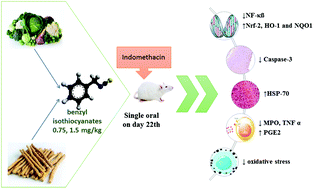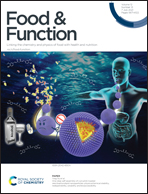Benzyl isothiocyanates modulate inflammation, oxidative stress, and apoptosis via Nrf2/HO-1 and NF-κB signaling pathways on indomethacin-induced gastric injury in rats
Abstract
The present study investigated the gastroprotective activity of benzyl isothiocyanates (BITC) on indomethacin (IND)-induced gastric injury in a rat model and explicated the possible involved biochemical, cellular, and molecular mechanisms. The rat model with gastric ulcers was established by a single oral dose of IND (30 mg per kg b.wt). BITC (0.75 and 1.5 mg kg−1) and esomeprazole (20 mg per kg b.wt) were orally administered for 3 weeks to rats before the induction of gastric injury. Compared with the IND group, BITC could diminish both the macroscopic and microscopic pathological morphology of gastric mucosa. BITC significantly preserved the antioxidants (glutathione GSH, superoxide dismutase SOD), nitric oxide (NO), and prostaglandin E2 (PGE2) contents, while decreasing the gastric mucosal malondialdehyde (MDA), tumor necrosis factor alpha (TNFα), and myeloperoxidase (MPO) contents. Moreover, BITC remarkably upregulated the expression of nuclear factor erythroid 2-related factor 2 (Nrf2), hemoxygenase-1 (HO-1), and NAD(P)H : quinone oxidoreductase (NQO1). In addition, BITC activates the expression of heat shock protein 70 (HSP-70) and downregulated the expression of nuclear factor-κB (NF-κB) and caspase-3 to promote gastric mucosal cell survival. To the best of our knowledge, this study is the first published report to implicate the suppression of inflammation, oxidative stress, and Nrf2 signaling pathway as a potential mechanism for the gastroprotective activity of BITC.



 Please wait while we load your content...
Please wait while we load your content...